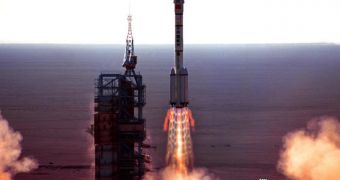Yesterday, August 24, the China National Space Administration (CNSA) launched a new mapping satellite in Earth's orbit.
The event took place at the Jiuquan Satellite Launch Center, a facility located in the Gobi Desert, near the Chinese-Mongolian border. The announcement was made by the official news agency Xinhua.
The Long March 2D delivery system that included the Tianhui 1 satellite blasted off at exactly 3:10 pm Chinese time (0710 GMT, 3:10 am EDT), and it managed to successfully release its payload at an altitude of about 300 miles (482 kilometers).
The rocket used to deliver the spacecraft is about 13 stories (33 meters) high, and is powered by two stages. Its maximum payload capacity to low-Earth orbit (LEO) is 3,100 kilograms (6,830 pounds).
Long March 2D flew for the first time in 1990. It was developed by researchers at the China Academy of Launch Vehicle Technology.
According to the official Xinhua news release, the Tianhui satellites was injected in an orbit with an inclination of 97 degree,. At this point, the spacecraft is in perfect health, Space reports.
Chinese authorities say that they will use the new instrument to collect more data on land resource available in China, and also for conducting mapping studies and scientific research from LEO.
The satellite's ultimate goal will be to promote Chinese economic development, says a statement published on the Chinese Ministry of Defense website.
Over the past few years, the Beijing government has had its sights set on space. The country finished conducting its first manned mission and its first spacewalk within the last five years.
At this point, CNSA is trying to develop spacecrafts that will exhibit in-orbit docking capabilities. The first flights to test the new technology will take place next year.
If they are successful, then the Chinese government will proceed towards building the country's first space station, and the third such major structure.
The station will follow the example set by the Russian Mir and the International Space Station (ISS). The latter will finished in February, after more than a decade of work.
The Chinese made no effort to conceal the fact that their own space station will also conduct military applications.

 14 DAY TRIAL //
14 DAY TRIAL //